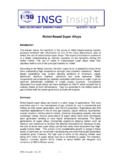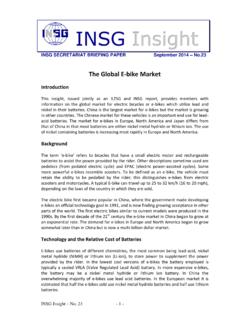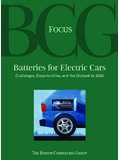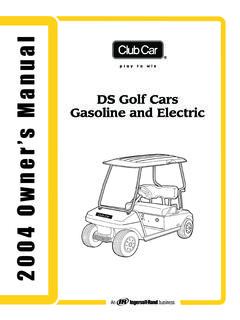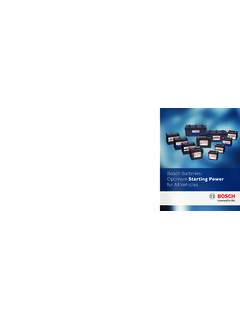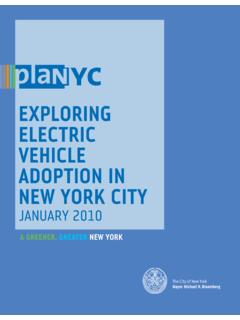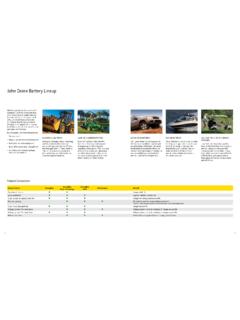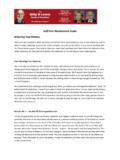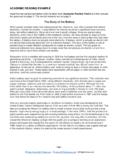Transcription of The Global E-bike Market - insg.org
1 INSG SECRETARIAT BRIEFING PAPER September 2014 The Global E-bike Market Introduction This insight, issued jointly as an ILZSG and INSG report, provides members with information on the Global Market for electric bicycles or e-bikes which utilize lead and nickel in their batteries. China is the largest Market for e-bikes but the Market is growing in other countries. The Chinese Market for these vehicles is an important end use for lead- acid batteries. The Market for e-bikes in Europe, North America and Japan differs from that of China in that most batteries are either nickel metal hydride or lithium ion. The use of nickel containing batteries is increasing most rapidly in Europe and North America. Background The term E-bike ' refers to bicycles that have a small electric motor and rechargeable batteries to assist the power provided by the rider. Other descriptions sometime used are pedelecs (from pedaled electric cycle) and EPAC ( electric power-assisted cycles).
2 Some more powerful e-bikes resemble scooters. To be defined as an E-bike , the vehicle must retain the ability to be pedalled by the rider; this distinguishes e-bikes from electric scooters and motorcycles. A typical E-bike can travel up to 25 to 32 km/h (16 to 20 mph), depending on the laws of the country in which they are sold. The electric bike first became popular in China, where the government made developing e-bikes an official technology goal in 1991, and is now finding growing acceptance in other parts of the world. The first electric bikes similar to current models were produced in the 1990s. By the first decade of the 21st century the E-bike Market in China began to grow at an exponential rate. The demand for e-bikes in Europe and North America began to grow somewhat later than in China but is now a multi-billion dollar Market . Technology and the Relative Cost of Batteries E-bikes use batteries of different chemistries, the most common being lead-acid, nickel metal hydride (NiMH) or lithium ion (Li-ion), to store power to supplement the power provided by the rider.
3 In the lowest cost versions of e-bikes the battery employed is typically a sealed VRLA (Valve Regulated Lead Acid) battery. In more expensive e-bikes, the battery may be a nickel metal hydride or lithium ion battery. In China the overwhelming majority of e-bikes use lead acid batteries. In the European Market it is estimated that half the e-bikes sold use nickel metal hydride batteries and half use lithium batteries. INSG Insight No. 23 -1- Cost is a major consideration in the selection of a battery type. For ease of comparison, cost may be defined in terms of Euros per kilowatt-hour ( /kWh). Estimates made in 2013. are that lead-acid batteries cost about 30/kWh, NiMH about 300/kWh and Li-ion up to 600/kWh. Thus a Li-ion battery is roughly twenty times more expensive per unit of energy than a lead-acid battery. However, it is anticipated that the price of Li-ion will decrease as more Li-ion batteries are produced.
4 One recent report claims that the automotive lithium-ion batteries built by Tesla Motors in partnership with Panasonic cost around $200 to $300 per kilowatt-hour. Reflecting the difference in the cost of the battery, e-bikes in China are much less expensive. By utilizing lead-acid batteries, the cost of e-bicycles in China averages about $167. In comparison, e-bikes in North America cost on average $815 and those in Western Europe average $1,546, reflecting the different choice in battery chemistry, according to Pike Research. Within the category of lithium ion batteries, there are several sub-categories. Examples include Lithium Iron Phosphate (LFP or LiFePO4), Lithium Manganese Dioxide (LiMnO2). and Lithium Nickel Manganese Cobalt Oxide (NMC). Some, but not all, types of lithium ion batteries use nickel, usually in the cathode. Lithium Nickel Manganese Cobalt Oxide (NMC) is one such battery and is often used in vehicles.
5 The cathode is composed of one- third nickel, one-third manganese and one-third cobalt. Another formulation is the Lithium Nickel Cobalt Aluminum (NCA or NiCoAl) battery. Tesla electric cars are reportedly now using Panasonic NCA batteries. The use of NMC or NCA batteries in e-bikes is a potential growth Market for nickel. Growth of the Market by Country In recent years electric cars have received a great deal of press coverage, but globally electric bicycles outsell electric cars by a wide margin. About 112,000 electric cars were sold worldwide in 2013. By comparison something in the region of 40 million e-bicycles were sold worldwide in 2013. In China, there are more electric bikes than cars on the road. The Global pattern for sales of e-bikes in 2013 has China in first place, at about 32. million, followed by Europe at million, and Japan at 440,000. The had sales of an estimated 185,000 e-bikes.
6 Further information for a number of countries with the largest E-bike sales is provided below. The Global Market for e-bikes is dominated by China, with an estimated 85 percent of all e-bikes being sold in China. It was estimated by Macquarie that, in 2013, there were 180. million e-bikes on the road in China, and that nearly 37 million new e-bikes were produced in the course of 2013. Projecting this growth into 2014 suggests that the total number of e-bikes in China will exceed 200 million this year. Note that about 37 million e- bikes were manufactured in China last year, with an estimated 32 million sold domestically. This suggests exports of around 5 million. Chinese E-bike production in 2013 was up from the previous year, according to Macquarie, a somewhat slower pace than in earlier years. Given the huge number of e- INSG Insight No. 23 -2- bikes in China it is not unexpected to see slower growth of E-bike production going forward as the Market may be becoming saturated.
7 An estimated 85 percent to 90. percent of e-bikes in China use lead acid batteries. Most Chinese electric bicycles using lead-acid batteries operate at 12 volts. Batteries for e-bikes using lithium batteries frequently operate at 24 volts or 36 volts. Sales of electric bicycles have grown rapidly in Europe in recent years. The Association of the European Two-Wheeler Parts and Accessories' Industries (COLIPED) has published data showing that European sales of electric power-assisted cycles has grown at annual rates of between 19 and 76 percent since 2006. Annual sales are approaching 1 million per year. Industry sources estimate that a Nickel-Metal-Hydride (NiMH) battery is used in around half the e-bikes sold in the European Union with the other half equipped with a Li- ion battery. In early 2014 COLIPED and the China Bicycle Association discussed harmonized safety standards for e-bikes and as part of this discussion it was proposed to stop the export of e-bikes with lead-acid batteries from China to Europe.
8 The table below provides details on total sales and Market evolution. Sales of electric Power-Assisted Cycles in Europe Year 2006 2007 2008 2009 2010 2011 2012. Sales 98 173 279 422 588 716 854. ( 000s). % - change Source: The Association of the European Two-Wheeler Parts and Accessories' Industries (COLIPED). The countries with the largest share of E-bike sales are Germany (45%), Netherlands (21%), France, Italy and Austria, (each with about 5%). As the largest Market in the EU, it is interesting to look at the case of Germany in more detail and to note that while regular bicycle sales are falling, e-bikes sales are growing. Bicycle Sales in Germany 2011-2013 (units). 2013 2012 2011. Bicycles mn mn mn E-bikes mn mn mn Total mn mn mn Average sales price 520 euro 515 euro 496 euro Market value bn euro bn euro bn euro Of the 410,000 electric bicycles sold in 2013 in Germany some 130,000 were imported and 278,000 were produced in Germany, with 58% of the E-bike imports from other EU.
9 Member states and 41% from Asia. Germany also exported e-bikes, with 87% of Germany E-bike exports destined to EU countries. In neighboring Austria e-bikes have a Market share of In Switzerland one in every seven bikes sold in an E-bike . Reportedly, over 250,000 e-bikes are currently in use on Swiss roads. In France 56,000 e-bikes were sold in 2013. INSG Insight No. 23 -3- In the United States, an estimated 185,000 e-bikes were sold in 2013, according to the electric Bikes Worldwide Report (EWBR), a trade publication. The EWBR highlights that there was an 80 percent sales growth in 2013 over 2012. In the typical prices for an E-bike range from about $1,000 to $3,500, with more sophisticated models costing $5,000. to $10,000. Most popular models are in the $1,000 to $1,500 range. This implies a total Market value in the range of $185 million to $277 million.
10 All battery types are sold in the Market , but e-bikes using lithium batteries seem to be growing in popularity. Japan has seen steady annual sales of about 300,000 for several years. The Market in Korea, Taiwan and other East Asian countries appears to be growing as well. International Trade in E-Bikes Asian countries are the largest manufacturers of e-bikes. For the EU, of all imported e-bikes originate in China. China was the source of over 300,000 e-bikes imported into the EU in 2013. Japan is Europe's number two supplier, with over 31,000 units and a share of the total imports. In third and fourth position, respectively, are Taiwan with 18,000 and Vietnam with 16,000 units. All other countries have less than 1% of the total imports. EU-27 Imports of E-bikes (in units) 2013. E-bike Country of origin units of China 304,301. Japan 31,399. Taiwan 18,273. Vietnam 15,751.
